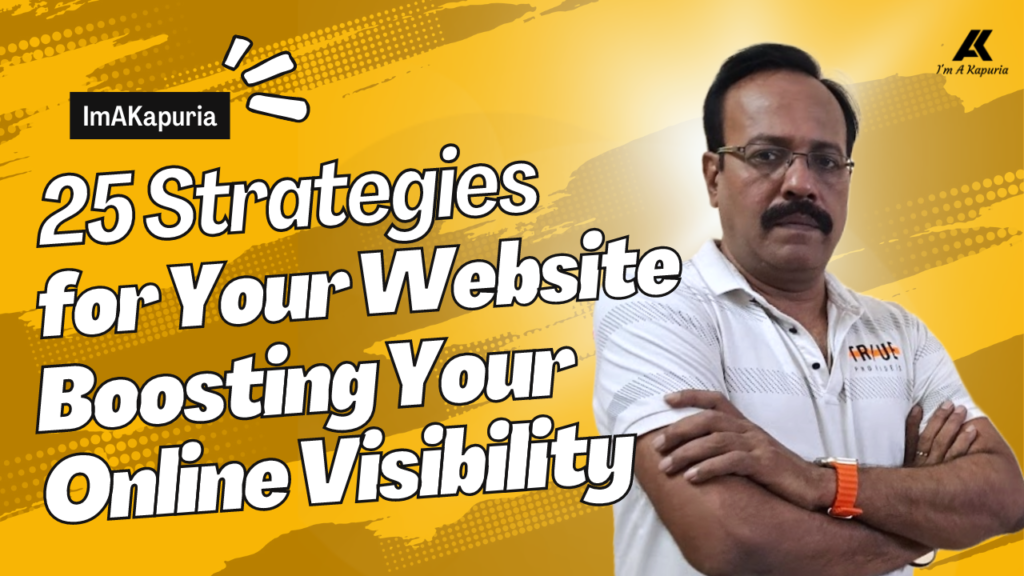Introduction
In today’s interconnected world, having a website is akin to having a storefront in the busiest street of the internet. It’s where you showcase your business, your skills, and your personality to the vast online audience. But merely having a website isn’t enough; you need to make sure it’s seen. You need to step into the digital spotlight.
Imagine your website as a beacon, guiding people who seek what you offer. Whether you’re a budding entrepreneur, a seasoned business owner, or an individual carving a niche in the online world, enhancing your website’s visibility is paramount. This comprehensive guide unveils 25 indispensable strategies you should regularly employ to ensure that your website shines brightly in the digital arena.
In today’s digital age, having a website is no longer an option; it’s a necessity. Whether you’re running a business or building a personal brand, your website serves as the digital face of your venture. But just having a website isn’t enough; you need to ensure that it’s visible to your target audience. In this article, we’ll explore 25 essential strategies to regularly implement, ensuring that your website gains the visibility it deserves.
1. Content Creation: Share Knowledge and Value
Regularly creating and sharing valuable content is the cornerstone of online visibility. Consider this: If you run a fitness blog, publishing articles about healthy living, workout routines, and nutrition tips not only keeps your audience engaged but also attracts new visitors seeking fitness advice.
2. SEO Optimization: Climbing the Digital Ladder
Search Engine Optimization (SEO) is like planting a flag on the internet. By optimizing your website for search engines, you increase the chances of showing up on the first page of Google’s search results when someone searches for relevant keywords. For instance, if you have a photography business, optimizing for keywords like “professional wedding photographer in [your city]” can make your website more discoverable.
3. Keyword Research: Understanding What Your Audience Searches For
Keyword research involves finding out what words and phrases people use when searching online. Suppose you’re a tech enthusiast. Understanding that people often search for terms like “best smartphones under 20,000” can guide your content creation efforts.
4. Content Promotion: Sharing Your Brilliance
Creating great content is just half the battle. Promoting it is equally crucial. Share your articles, videos, or podcasts on social media, forums, and online communities where your target audience hangs out.
5. Email Marketing: Building a Loyal Tribe
Email marketing is a powerful tool to keep your audience informed and engaged. Regular newsletters sharing your latest content or exclusive offers can nurture relationships and keep your brand top-of-mind.
6. Social Media Posting: Stay Connected
In today’s connected world, a strong social media presence is vital. Share your content, engage with your audience, and participate in conversations relevant to your niche. If you’re a fashion enthusiast, regularly posting outfit ideas on Instagram can keep your followers engaged.
7. Networking: Connecting with Like-Minded Individuals
Don’t underestimate the power of networking. Engaging with others in your industry or niche, whether through online forums or real-world events, can lead to valuable partnerships and insights.
8. Online Advertising: Boosting Visibility
Sometimes, it’s worth investing in online advertising. Platforms like Google Ads and social media ads allow you to target specific demographics. If you’re launching a new product, consider running a targeted ad campaign.
9. Guest Posting: Sharing Your Expertise
Guest posting involves writing articles for other reputable websites in your field. This not only expands your reach but also establishes you as an authority in your niche.
10. Social Media Advertising: Reaching the Right Audience
Social media ads are a cost-effective way to reach a broader audience. If you’re an interior designer, running a Facebook ad showcasing your recent projects can attract potential clients.
11. Website Maintenance: Keeping Things Shipshape
A well-maintained website not only performs better but also leaves a positive impression on visitors. Regularly update content, fix broken links, and ensure a seamless user experience.
12. Analytics Review: Data-Driven Decisions
Website analytics tools like Google Analytics provide valuable insights into your website’s performance. Regularly reviewing these metrics helps you make data-driven decisions. For instance, if you notice a particular blog post receives more traffic, you can create similar content to capitalize on its success.
13. Content Calendar: Staying Organized
Planning and scheduling your content in advance ensures consistency. A content calendar helps you maintain a steady flow of fresh material, which search engines love.
14. Social Media Calendar: Timing is Everything
Just as with content, scheduling social media posts in advance ensures you’re consistently engaging with your audience. If you’re a travel blogger, plan posts that coincide with peak travel seasons to reach a larger audience.
15. Competitor Analysis: Learning from Others
Monitoring your competitors allows you to identify trends and strategies that work. Analyze their content, social media activities, and audience engagement. For instance, if you’re in the e-commerce business, studying successful competitors can provide insights into effective product descriptions or marketing tactics.
16. Engagement: Building Relationships
Engagement isn’t a one-way street. Always respond promptly to comments, messages, and inquiries from your website visitors and social media followers. It’s a way of showing that you value their input.
17. Online Reviews: Harnessing Social Proof
Positive online reviews on platforms like Google My Business can significantly impact your brand’s credibility. Encourage satisfied customers to leave reviews and testimonials. If you’re a local restaurant, glowing reviews can attract more diners.
18. Webinars and Workshops: Sharing Your Knowledge
Hosting online webinars or workshops related to your expertise is an excellent way to connect with your audience and showcase your skills. If you’re a digital marketer, a webinar on effective SEO strategies can engage your audience and establish your authority.
19. Cross-Promotion: Growing Together
Collaborating with other businesses or influencers in your niche can be mutually beneficial. For instance, if you’re a beauty blogger, team up with a cosmetics brand for a joint Instagram giveaway. This way, you both reach a broader audience.
20. Email Outreach: Building Connections
Don’t hesitate to reach out to industry influencers or potential partners via email. Whether you’re looking for collaboration opportunities or seeking expert advice, a well-crafted email can open doors.
21. Monitor Trends: Staying Current
The digital landscape is ever-evolving. Keeping abreast of emerging trends and industry developments ensures your content and strategies remain relevant. For example, if you’re in the technology space, regularly update your audience on the latest gadgets and innovations.
22. Data Analysis: Decisions Based on Insights
Regularly review and analyze website and marketing data to make informed decisions. If you notice a decline in traffic to a particular product page, investigate and make improvements.
23. User Experience (UX) Improvement: Visitor Satisfaction
A seamless user experience is essential. Ensure that your website is easy to navigate, loads quickly, and provides a pleasant experience. A user-friendly site encourages visitors to stay longer and engage more.
24. Conversion Rate Optimization (CRO): Maximizing Results
CRO involves improving elements on your website to increase desired actions, such as newsletter sign-ups or product purchases. Regularly testing and optimizing your site can lead to higher conversion rates. If you run an e-commerce store, tweaking product descriptions or streamlining the checkout process can boost sales.
25. Innovate and Experiment: Embrace Change
Finally, don’t be afraid to try new things. The digital world is dynamic. Experiment with different content formats, platforms, or technologies to see what resonates best with your audience. Remember, innovation often leads to growth.
Conclusion:
Your website is not just a virtual space; it’s your digital identity. It’s where you connect, engage, and influence. By implementing these 25 strategies with diligence and consistency, you can amplify your online presence and draw your target audience closer. Whether you’re sharing knowledge, selling products, or simply showcasing your passion, these strategies are your keys to unlocking the vast potential of the internet.
Remember, online visibility is not a one-time endeavor; it’s a continuous journey. Keep creating, optimizing, and engaging. Stay attuned to the evolving digital landscape, and never stop innovating. Your website is your canvas, and with each stroke of digital brilliance, you paint a brighter future for your business or personal brand. So, go ahead, take the stage, and shine in the digital spotlight.






Pingback: 25 Reasons: why your business needs a website - Abhijit Kapuria